

Jackson Huckaby
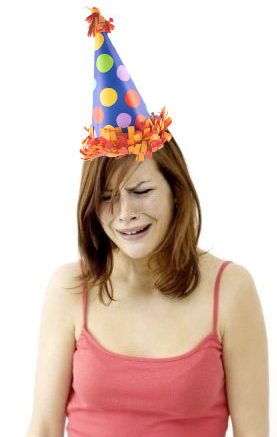
No, Its MY birthday!
If you were in a room with 30 people and had to guess the probabilty that you shared a birthday with one of you friends what would you say?
Imagining that there are 365 days in most years, and there are only 29 other people in the room most likely you would assume that probabilty is pretty low.
What would you say if I told the probability of a "birthday match" within a group of 30 people was 71%?
Doubtful? Try it out.
Meanwhile, here is the mathematical reasoning.
Formal question:
If you have 30 students in your classroom. (Yikes) What is the probability that at least two of them share the same birthday?
It is important that you stress the "at least" qualifier in the question, this can include not only two people sharing a birthday, but also three, or four, etc...
This seems to be a daunting task to simulate, however with some simple clever mathematical principles we can present this case quite nicely.
The key to this is the idea that the probability of at least one match, will be equal to the complament of the probability of finding no matches,
now we see why the at least is so important.
So: P(at least one match)=1-P(0 matches)
To begin working we will build our reasoning, obviously one student alone cannot have a match, but suppose there are two students in a room.
What is the probability that they will not share the same birthday?
We can randomly select the first students birthday, then the second student has 354/365 options to not share the same birthday.
So the prob of two students not matching is 354/365. So the probability of a match will be the complament of this, or
1-(364/365)= (1/365)
Approx. 00.274%
Now that we see our way of reasoning let us build it to consider three students in a room.
The probability of #2 being different is 364/365. Now for student three, two days have been chosen. We assume they are different because otherwise we are done. So there are 2 days of the year take, therefore a successful birthday (one not taken) will have a probability of (363/365).
So our probability of a match will be 1-(364/365)(363/365).
Approx. 00.82%
So far, you could say that these results follow what you may expect.
Now is the fun part. You can continue calculating this by hand if you wish:
Prob(0match)=Prob(student1,2,3,4,5....30) all have different birthdays.
1-P(0match)= Our probabilty of a match.
Feel free to work this our and see if you come to a probability of .7063.
This is fun, but what if we have 23 students? 34 students? 120 students? Do we want to calculate this every single time?
As a technological solution I will turn to Excel.
We will go through the step by step process together. In column A we will list student numbers.
In column B I will calculate the probability of this particular student not matching with all of the students before hand. Keep in mind this is not a final step this is simply part of the process.
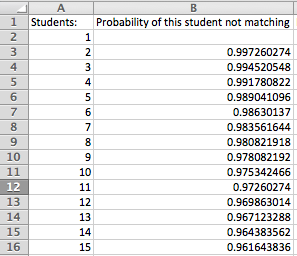
In column C I am going to calculate the probability that there are no matches up to this point. This is where we include all the previous students.
To do this I calculated C3 to be: B3*B2, and then C4 to be B4*B3*B2.
Instead of continuing this trend we can see that can observe that in order to get C4 we just needed to multiply C3 by B4. So this was my new trend,
In C5 I did C4*B5. This gave me the pattern I needed so I could drag down from this point.
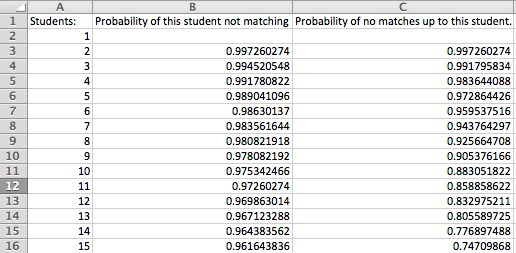
If you are following along your graph should be yielding the same values.
And finally, in column D I calculate the Probability that there will be a match in a group of x number of students.
To do this I simply did 1 minus the corrisponding row in column C.
F.I. In DC I typed =1-C3.
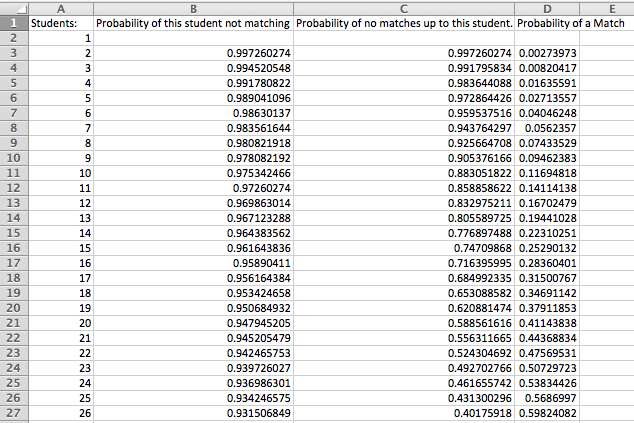
So we can now check our work! According to excel, our probability of a match between 30 students is 70.63%!
You can find my worksheet here.
Now we can create a scatter plot of the data.
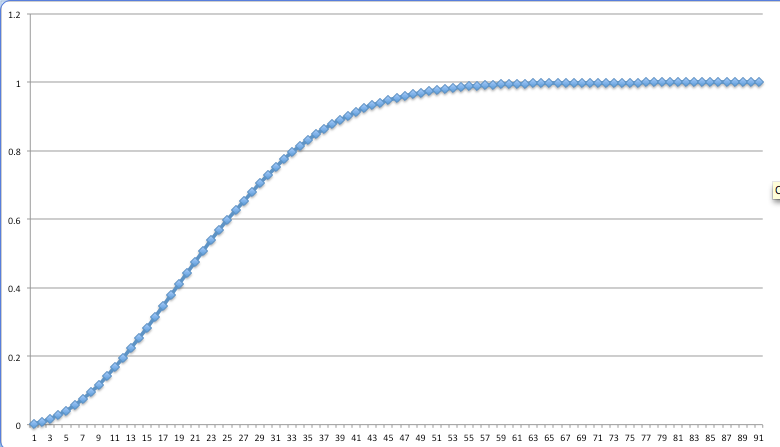
This represents our probability of success on the Y axis and our number of students on the X axis.
Some interesting discussions can be held with students about their thoughts on the graph.
What type of regression is this?
Why does there appear to be two asymptotes in the graph? What in the algebraic function causes this?
At what point are you willing to gamble with a class or group of students over this information?
After all, if you have a group of 26 students you have a 59.82% chance of being right.
Return Home
This idea has been modified from Dr. Franklins Statistics Class.